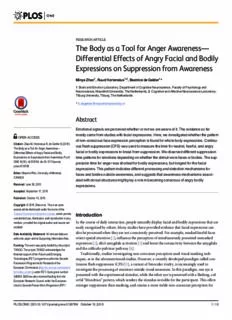
The Body as a Tool for Anger Awareness—Differential Effects of Angry Facial and Bodily PDF
Preview The Body as a Tool for Anger Awareness—Differential Effects of Angry Facial and Bodily
RESEARCHARTICLE — The Body as a Tool for Anger Awareness Differential Effects of Angry Facial and Bodily Expressions on Suppression from Awareness MinyeZhan1,RuudHortensius1,2,BeatricedeGelder1* 1 BrainandEmotionLaboratory,DepartmentofCognitiveNeuroscience,FacultyofPsychologyand Neuroscience,MaastrichtUniversity,TheNetherlands,2 CognitiveandAffectiveNeuroscienceLaboratory, TilburgUniversity,Tilburg,TheNetherlands *[email protected] Abstract Emotionalsignalsareperceivedwhetherornotweareawareofit.Theevidencesofar mostlycamefromstudieswithfacialexpressions.Here,weinvestigatedwhetherthepattern OPENACCESS ofnon-consciousfaceexpressionperceptionisfoundforwholebodyexpressions.Continu- Citation:ZhanM,HortensiusR,deGelderB(2015) ousflashsuppression(CFS)wasusedtomeasurethetimeforneutral,fearful,andangry TheBodyasaToolforAngerAwareness— DifferentialEffectsofAngryFacialandBodily facialorbodilyexpressionstobreakfromsuppression.Weobserveddifferentsuppression ExpressionsonSuppressionfromAwareness.PLoS timepatternsforemotionsdependingonwhetherthestimuliwerefacesorbodies.Thesup- ONE10(10):e0139768.doi:10.1371/journal. pressiontimeforangerwasshortestforbodilyexpressions,butlongestforthefacial pone.0139768 expressions.Thispatternindicatesdifferentprocessinganddetectionmechanismsfor Editor:MauricePtito,UniversityofMontreal, facesandbodiesoutsideawareness,andsuggeststhatawarenessmechanismsassoci- CANADA atedwithdorsalstructuresmightplayaroleinbecomingconsciousofangrybodily Received:June26,2015 expressions. Accepted:September17,2015 Published:October15,2015 Copyright:©2015Zhanetal.Thisisanopen accessarticledistributedunderthetermsofthe CreativeCommonsAttributionLicense,whichpermits Introduction unrestricteduse,distribution,andreproductioninany medium,providedtheoriginalauthorandsourceare Inthecourseofdailyinteraction,peoplenaturallydisplayfacialandbodilyexpressionsthatare credited. easilyrecognizedbyothers.Manystudieshaveprovidedevidencethatfacialexpressionscan alsobeprocessedwhentheyarenotconsciouslyperceived.Forexample,maskedfearfulfaces DataAvailabilityStatement:Allrelevantdataare withinthepaperanditsSupportingInformationfiles. orientspatialattention[1],influencetheperceptionofsimultaneouslypresentedunmasked expression[2],elicitamygdalaactivation[3]andboosttheconnectivitybetweentheamygdala Funding:Theworkwaspartlyfundedbytheproject andthecolliculo-pulvinarpathway[4]. TANGO.TheprojectTANGOacknowledgesthe financialsupportoftheFutureandEmerging Traditionally,studiesinvestigatingnon-consciousperceptionusedvisualmaskingtech- Technologies(FET)programmewithintheSeventh niques,asintheaforementionedstudies.However,arecentlydevelopedparadigmcalledcon- FrameworkProgrammeforResearchofthe tinuousflashsuppression(CFS)[5],avariantofbinocularrivalry,isincreasinglyusedto EuropeanCommission(http://ec.europa.eu/research/ investigatetheprocessingofemotionsoutsidevisualawareness.Inthisparadigm,oneeyeis fp7/index_en.cfm),underFET-Opengrantnumber: presentedwiththeexperimentalstimulus,whiletheothereyeispresentedwithaflashing,col- 249858.BdGhasalsoreceivedfundingfromthe orful“Mondrian”pattern,whichrendersthestimulusinvisiblefortheparticipant.Thisoffers EuropeanResearchCouncilundertheEuropean Union’sSeventhFrame-WorkProgramme(FP7/ strongersuppressionthanmasking,andcreatesamorestablenon-consciousperceptionfor PLOSONE|DOI:10.1371/journal.pone.0139768 October15,2015 1/13 TheBodyasaToolforAngerAwareness 2007–2013)/ERCgrantagreementnumber295673. participants[6].CFSexploitstherivalryofthedichopticstimuli,hypotheticallyoccurringat Thefundershadnoroleinstudydesign,data bothmonocularneuronsinlower-levelvisualareasandbinocularpatternselectiveneuronsin collectionandanalysis,decisiontopublish,or highervisualareas[7].Previousstudiesusingthisparadigmhaveshownthatfacialstimuli preparationofthemanuscript. withcertainemotionalcontentscanbeprocessedwithoutawareness[8],andthattheseemo- CompetingInterests:Theauthorshavedeclared tionalcontentscanaffectjudgmentsmadebyparticipantsafterwards[9]. thatnocompetinginterestsexist. AlthoughCFScangenerallysuppressvisualstimuliforarelativelylongtime,theactual durationofsuppressiontendstovarywiththestimuluscategoryaswellaswithcertainproper- tiesofthestimuli.Inparticular,stimulithataresalientormeaningfultotheparticipantmay breakfromsuppressionfaster[6].Thisdifferenceinsuppressiontimebetweenstimulicanbe usedtoinferthedifferencesinnon-consciousprocessingbeforetheyreachawareness[10]. Thisbreaking-from-suppression(CFS-b)paradigmhasbeenutilizedtostudyprocessingdif- ferencesofhigh-levelfeaturesincludingemotions.Forfacialexpressionsofemotion,studies usingfearfulfacesprovidedmixedresults[11–15].Threeofthemshowedthatfearfulfaces tendtobreakfromsuppressionfasterthanotheremotionalfacialexpressions[11–13],under- scoringtheattention-grabbingstatusoffearfulfacialexpressionsthatwasfoundinmasking studies[16]. Thecurrenthumanemotiontheoriesmaybeincompleteduetoanemphasisonthefacial expressions;animportantquestioniswhethertheeffectsobtainedwithfacialexpressionsalso generalizetobodilyexpressionsofemotions.Bodilyexpressionsarepotentemotionalsignals whenperceivedconsciously[17],astask-irrelevantinformationunderattentionmanipulation [18],butalsodosowhenprocessedoutsidevisualawareness.Thishasbeendemonstratedin somepatientswithcorticalblindnessduetovisualcortexlesion,whoshowaffectiveblindsight, theabilitytostillbeabletoprocessvisualemotionalsignals[19].Forexample,emotionalbod- iespresentedintheblindvisualfieldelicitedactivationsinsubcorticalstructuresincluding superiorcolliculusandpulvinar[20],andelicitedsimilarfacialmusclereactionstotheones presentedinthesightedvisualfield[21].Studieswithneglectpatientsalsoshowedthatexpo- suretoimageswithemotionalbodiessubstantiallyreducedtheattentionaldeficits[22,23]. Togetherwithmaskingstudiesinhealthyparticipants[24,25],thesestudiesprovideevidence fortheprocessingofbodilyexpressionsofemotionoutsideawareness.Inviewofthefactthat maskingmethodsarenotalwaysconclusive[26],convergentevidencefromotherapproaches isdesirable. TheCFSparadigmhassofarnotbeenusedtoinvestigatenon-consciousperceptionofemo- tionsexpressedbybodypostures.Inthecurrentstudy,weusedtheCFS-bparadigmtoexamine suppressiontimedifferencesamongstimuliwithneutral,fearful,andangryemotions,con- veyedbyeitherthefaceorthebody.Ourstudyaimedtoanswerthreequestions.First,canCFS alsobeusedtoinvestigatenon-consciousemotionalbodyprocessingandifso,aretherediffer- encesinsuppressiontimesofthedifferentemotions?Second,isthepatternofsuppression timedifferencesbetweenemotionssimilarforbodilyandfacialexpressions?Finally,inviewof adebateonthisissueintheliterature,canweaddnewevidenceaboutthesuppressiontimes underCFSforemotionalfacialexpressions? Methods Participants ParticipantswererecruitedfromtheMaastrichtUniversitycampus(n=32,meanage=21.7, rangingfrom18–30,withsevenmaleandthreeleft-handedparticipants).Allparticipantshad normalstereoandcolorvision,normalorcorrected-to-normalvisualacuity,andnohistoryof neurologicaldisorders.Theyprovidedwrittenconsentandreceivedeithercreditpointsor monetaryrewardafterwards.TheprocedureforthestudywasapprovedbytheEthics PLOSONE|DOI:10.1371/journal.pone.0139768 October15,2015 2/13 TheBodyasaToolforAngerAwareness CommitteeofMaastrichtUniversity,andwascarriedoutinaccordancewiththestandards establishedbytheDeclarationofHelsinki. Stimuli Thestimuliwerefaceandbodyimagesingrayscale.Eachstimuluscategoryhad24identities, andeachidentityhadaneutral,angry,andfearfulexpression.Thefacestimuliwereadapted fromtheRadboudFacesDatabase[27].Theywerealignedattheeyelevel,andanellipse(from belowthechintothetopofthehead,1.91°×2.67°ofvisualangle)maskedoutthevisualdetails foreachfacialstimulusoutsidethatregion.ThebodystimuliwereadaptedfromStienenand deGelder[24],withfacialinformationremoved,andalignedattheshoe-level.Neutralstimuli consistedofindividualstalkingonthephone.Thebodystimulispannedwithin1.8°×4.3°visual angles.Sinceourinterestliesmoreontheeffectsofdifferentemotionswithinthesamestimu- luscategory(eitherfaceorbody),andtheemotionsperformedbythesameindividualwere photographedunderthesamelightingconditionsandcamerasettings,tokeeptheecological validity,weusedthefull-contrastimageswithoutfurtherbalancingtheluminanceandcontrast acrossemotions,oracrossstimuluscategory.Instead,thelow-levelpropertieswerecontrolled byperformingmixed-modelsanalyses.Fig1Ashowsexamplesofthestimuliused. Procedure ThestimuliwerepresentedinMATLAB(theMathWorks,Natick,MA,USA)withPsychtool- box[28,29],onanLCDscreen(AcerVG248,3Dcapable,resolution=1920×1080,refresh rate=60Hz),inaroomwithdimlight.Thebackgroundofthescreenwassettogray(RGB value=128,128,128).Inthemiddleofthescreen,tworectangles(240x160pixels,6.4°x4.27°of visualangles)wereplacedsidebysideandthecentersoftherectangleswere250pixelsapart (visualangle=6.67°).Aframeof10pixelsdelineatedtheborderoftherectangles,andablack Fig1.ExamplesofstimuliandtheCFS-bprocedure.(A)Examplesoffaceandbodystimuli,withneutral,fearfulandangryemotionalfacialandbodily expressionswereused.(B)TheCFS-bprocedure. doi:10.1371/journal.pone.0139768.g001 PLOSONE|DOI:10.1371/journal.pone.0139768 October15,2015 3/13 TheBodyasaToolforAngerAwareness fixationcrosswasplacedinthecenterofeachrectangle.Thefixationcrossesandtheframes helpedtomaintainconvergenceofthetworectanglesforparticipants. Achinrestwasplaced59cmawayfromthescreen.Participantsviewedthescreenthrough apairofdiopterglasses(thediopterforeachlens=7).Thediopterswerecalculatedandchosen accordingtothevisualanglebetweenthetworectangles[30],whichwouldshifteachrectangle backtothecenterofscreenuponviewing.Acardboarddividerwasplacedbetweenthescreen andthechinrest,dividingthescreenintotwoequalhalves.Participantswereinstructedtofix- ateonthecrossandfree-fusethetworectanglesintoone.Theexperimentwouldstartonly afterparticipantsreportedthattheycouldclearlyseeonlyonerectangle,andthattheviewwas stable.Allparticipantsreportedsuccessfulandstablefusion.Withthissetup,eithereyeofthe participantcouldseeonlythecontentoftheipsilateralrectangle. Inatrial,adynamicnoise(160×240pixels,flashingat10Hz)wasprojectedintooneofthe rectangularframes.Thenoiseimagesconsistedofoverlappingandcolorfulsmallrectangles (withheightandwidthwithin2°).Thenoiseimagesineachtrialweredrawnrandomlyfrom 600uniquenoiseimages.Onestimulusimbeddedinthesamegraybackgroundwasprojected intotheotherrectangularframe,asthetargetstimulus.Ineachtrial,theinitialfixationcross changedtowhiteonesecondbeforethestartofthetrial,andremainedwhitethroughoutthe trial.Intheinter-trialintervals(length=4s),thefixationcrosschangedbacktoblack.Each trialhadadurationof9s.Thestimuluswasgraduallyrampedupfrom0%contrasttofullcon- trastinthefirst8s,andremainedatfullcontrastforanother1s.Thecontrastofthenoisewas rampeddowninthefirst8secondsto0%.Thusinthe9thsecondonlythestimuluswaspre- sentedinoneoftherectangles.Participantswereinstructedtofixatecontinuously,toblinkas littleaspossibleduringatrial,andtopressthespacebaronthekeyboardassoonastheyper- ceiveanythingelseotherthanthedynamicnoise.Fig1BpresentstheCFS-bprocedure.Wedid notprovidetheparticipantswithanypriorknowledgeaboutthenatureofthesuppressedsti- muliinordertoexcludepossibletop-downeffects. Thefaceandbodystimuliwerepresentedintwoseparateblocks.Theorderoftheblocks wascounterbalancedbetweenparticipants.Eachindividualstimuluswaspresentedoncein eacheye.Oneblockconsistedof144trials,randomizedwithintheblock,andbalancedbetween theeyes.Inthemiddleofeachblocktherewasashortbreak. Aftertheexperiment,participantswereaskedtofree-recalltheemotioncategoriesthatthey recognized,andwhethertheyclearlyperceivethewholestimuliatthetimetheypressedthe key.Iftheycouldnotlabeltheemotionofthebody,theywereaskedtodescribetheposture. Mainanalyses ThedatawereanalyzedinSPSSandR(RCoreTeam,Vienna,Austria).Forremovingoutliers, thesingle-trialsuppressiontimeswerez-transformedforthedataofeachblockseparately,and alsoacrossthetwoblocksforeachparticipant.Thedatapointsthatexceedfourstandarddevia- tions(SD)ineitheroneofthez-transformationsperformedwereexcludedasoutliers.Trials withoutaresponse(suppressiontime(cid:1)9s)werealsoexcluded.Intotal,1.13%ofthetrials wereexcluded.Inthefaceblock,meannumberofexcludedtrialswas1outof144trials (SD=1.29).Inthebodyblock,foroneparticipant28trialswereremovedduetonoresponse, whilefortheotherparticipantsmeannumberofexcludedtrialswas1outof144trials, SD=1.8.Therewasnodifferencebetweenthefaceandbodyblocksinthenumberofoutliers removed,t(31)=-0.351,p=.728. Therawsuppressiontime(inseconds)wasaggregatedbyparticipant.Atwo-wayfactorial repeated-measureANOVAwasperformed,withcategory(face,body)andemotion(neutral, fear,anger)aswithin-subjectsfactors.Pairedsamplesttestswereusedforpost-hoctesting. PLOSONE|DOI:10.1371/journal.pone.0139768 October15,2015 4/13 TheBodyasaToolforAngerAwareness Mixedmodelscontrolanalyses Wealsotooklow-levelpropertiesofthestimuliintoconsiderationbyperformingmixedmod- elsanalyses.Sinceweexpectthatthelow-levelpropertieswillaffectthetwostimulicategories differently,themixedmodelsanalyseswereperformedseparatelyonthedataofthefaceand thebodyblocks.Aslow-levelproperties,wecountedthenumberofpixelsforeachbodyand facestimulus,andobtainedtheaveragepixelvalueforeach.Wealsoobtainedtheroot-mean- squarecontrastsofthewholebodystimuli,andoftheeye-eyebrowregionofthefacestimuli. Thepixelcount,meanpixelvalue,andtheRMScontrastswerecentered,andresidualized ontheemotiontypesusingSPSS,andtheresidualscorrespondedtothepartnotexplainedby theemotiontypes.Themulticollinearitycheckswereperformedforthefaceandthebodydata separately.Theemotiontype,withtheresidualizedpixelnumber,meanpixelvalue,andRMS contrastwereenteredintoabackwardregressionmodelaspredictors.Thesuppressiontime wasdefinedasthedependentvariable.Multicollinearitychecksshowedavarianceinflationfac- torbelow1.5forallthepredictors,suggestingthattheywerefreeofmulticollinearityproblems. Inthefollowingparagraphsthe“residualized”willbeomittedforconciseness. ThemixedmodelsanalyseswereperformedinR(RCoreTeam,Vienna,Austria).Thelin- earmixedmodelswereconstructedandcomparedwiththelme4toolbox[31].Forthemodels, fixedeffectpredictorsincluded:emotiontype,pixelcount,meanpixelvalue,RMScontrast;ran- domeffectsincluded:participant,stimulus,wherethestimuluspredictorisaby-itempredictor forthestimuli.Thedetailsofmodelcomparisonstepsaredescribedintheresultsession.The least-squaredmeanestimatesforthefixedeffectemotiontypewasobtainedusingthelsmeans [32]andpbkrtest[33]toolboxes.Themodelsthatdifferedinrandomeffectpredictorswerefit- tedbytherestrictedmaximumlikelihoodmethod(REML),andthemodelsthatdifferedin fixedeffectpredictorswerefittedbythemaximumlikelihoodmethod(ML).Thefinalmodel wasthenfittedwithREMLtoobtainthelinearestimates. Results Resultsofthemainanalyses Therewasasignificantmaineffectsofcategory,F(1,31)=71.20,p<.000001,η 2=0.70,and p ofemotion,F(2,62)=8.47,p=.0006,η 2=0.21.Importantly,therewasasignificantinterac- p tionbetweencategoryandemotion,F(2,62)=28.64,p<.001,η 2=0.48. p Post-hocpaired-samplest-testsrevealedthatthesuppressiontimeforangryfaces (M=3.45,SE=0.21)wassignificantlylongerthaneitherneutral(M=3.23,SE=0.19),t(31)= 3.93,p<.001,r=0.57,orfearfulfaces(M=3.23,SE=0.18),t(31)=3.60,p=.001,r=0.54. Thedifferencebetweenneutralandfearfulfacialexpressionswasnotsignificant,t(31)=0.04, p=.97,r=0.01. Incontrast,suppressiontimeforangrybodieswassignificantlyshorter(M=4.11, SE=0.21)comparedtofearful(M=4.58,SE=0.23),andneutral(M=4.26,SE=0.20)bodies, witht(31)=7.67,p<.001,r=0.81andt(31)=2.63,p=.013,r=0.43,respectively.Suppres- siontimeforfearfulbodieswaslongercomparedtoneutralbodies,t(31)=-4.29,p<.001, r=0.61(Fig2). Totestiftheorderoftheblocksinfluencedtheresults,weaddedorder(face!bodyversus body!face)asabetween-subjectsfactorintherepeated-measureANOVA.Therewasnomain effectoforder,F(1,30)=1.09,p=.31,η 2=0.04,oremotionbyorderinteraction,F(2,60)=0.98, p p=.38,η 2=0.03.Asignificantinteractionbetweencategoryandorderappeared,F(1,30)= p 35.34,p=.000002,η 2=0.54.Thegroupwiththebodyblockfollowingthefaceblock(n=16, p M=3.87,SE=0.28)showedshortersuppressiontimesforthebodycategorycomparedtothe PLOSONE|DOI:10.1371/journal.pone.0139768 October15,2015 5/13 TheBodyasaToolforAngerAwareness Fig2.Resultsofthefaceandbodyblocks.Suppressiontimeforneutral,fearful,andangryfacialandbodilyexpressions.Errorbarsrepresentstandard errors.*:p<.05;***:p<.001. doi:10.1371/journal.pone.0139768.g002 groupwiththefaceblockfollowingthebodyblock(n=16,M=4.76,SE=0.28),t(30)=-2.23,p =.03,r=0.38.Thiswasnotthecaseforfaces,t(30)=0.24,p=.81,r=0.04(face!body: M=3.35,SE=0.29,andbody!face,M=3.26,SE=0.25).Crucially,thethree-wayinteraction betweenorder,emotionandcategorywasnotsignificant,F(2,60)=0.47,p=.63,η 2=0.02. p Orderdidnotinfluencethemainresults. Inaddition,wecheckedwhethertheparticipantsbasedtheirdecisiononaconsistentbasis withineachblock,andiftheydidn’twaittoolongforaclearperceptionofthestimuli.Allpar- ticipantsreportedthattheypressedtheresponsebuttonassoonaspossible,buttheirpartial- wholeperceptionvariedwhenpressingthebutton:20participantssawthewholestimulimost ofthetime,7participantssawpartialfeaturesmostofthetime,and5participantshadamixed perception.Totestifseeingthewholeorpartialofthestimuliaffectedtheobservedresults,we addeditasabetween-subjectfactorintherepeated-measureANOVA.Therewasnomain effectofstimulicompleteness,F(2,29)=0.27,p=.77,η 2=0.02.Nointeractionofstimulicom- p pletenesswaspresentwitheithercategory,F(2,29)=0.51,p=.60,η 2=0.03,oremotion,F p (2,29)=1.57,p=.19,η 2=0.10,orwithcategoryandemotiontogether,F(4,58)=0.94,p=.45, p η 2=0.06. p Resultsofthemixedmodelscontrolanalyses Facestimuli.First,model1wasconstructedwithonefixedeffectpredictor(emotiontype),and twoseparaterandomeffectpredictors(participant,stimulus).Aninterceptandrandomslope foremotiontypewasincludedintheparticipantpredictor.Themodel1hadthemaximalran- domeffectstructurejustifiedbythedata.Asecondmodel(model2)excludedtherandom slopeofemotiontypeintheparticipantpredictor.Comparisonofthesetwomodelsshowed thatmodel1,withtherandomslope,betterdescribedthedata,χ2(5)=13.86,p=.016.Theran- domslopewaskeptinthesubsequentmodels. Model3,4and5wereconstructedbyaddingasecondfixedeffectpredictor,respectively: pixelcount(model3),meanpixelvalue(model4),RMScontrastfortheeye-eyebrowregion (model5).Model5withRMScontrastdescribedthedatabetterthanmodel1,χ2(1)=24.52,p <.001.Theestimate(β)forthepredictorRMScontrastwas-0.03,SE=0.005,t=-5.41,p= .0001.Thepvaluewasobtainedusingthepbkrtesttoolbox,with10000simulationsamples. PLOSONE|DOI:10.1371/journal.pone.0139768 October15,2015 6/13 TheBodyasaToolforAngerAwareness Fig3.Suppressiontimeforneutral,fearful,andangryfacialandbodilyexpressionsaftercorrectingforlow-levelfeaturesunrelatedtoemotion. Errorbarsrepresentstandarderrors.*:p<.05;**:p<.01;***:p<.001. doi:10.1371/journal.pone.0139768.g003 Subsequentlyaddingpixelcountandmeanpixelvaluetomodel5respectivelywasn’tjustified bytheχ2change.Themodel5wasselectedasthefinalmodel. Inthefinalmodel,withemotiontypeandRMScontrastasfixedeffectpredictors,theleast squaredmeansofthecontrastsalsoshowedsimilarresultstothoseintheANOVAanalysis, neutralversusfearfulfaces:t(38.93)=1.88,p=.159;neutralversusangryfaces:t(32.42)= -3.73,p=.002,fearfulversusangryfaces:t(39.40)=-4.99,p<.0001.Theestimateforfearful faceswas0.12sshorterthanneutralfaces,whichwasapatternalsoshownintheliterature,but thisdifferencewasstillnotsignificant(Fig3andTable1). Bodystimuli Themodelcomparisonsforthebodystimulifollowedasimilarprocedureasthosefortheface stimuli.Model1and2weresimilarlyconstructed,witharandomslopeforemotiontypeinthe Table1. Estimates(βvalues,inseconds),standarderrors,andtvaluesforthefixed-effectpredictors intheanalysesforthefaceandbodyblocks. Predictor Estimate(s) SE t Facestimuli Intercept(neutralfaces) 3.275 0.184 17.845 Fearfulvs.neutralfaces -0.120 0.062 -1.923 Angryvs.neutralfaces 0.216 0.056 3.834 RMSContrastoftheeyeregion -0.031 0.006 -5.411 Bodystimuli Intercept(neutralbodies) 4.264 0.202 21.099 Fearfulvs.neutralbodies 0.317 0.083 3.846 Angryvs.neutralbodies 0.152 0.066 -2.308 Meanpixelvalueofthestimulus 0.009 0.001 6.708 Thepvaluesintheanalyseswereobtainedbythelsmeansandpbkrtesttoolboxes,thuswerereported separatelyinthetext. doi:10.1371/journal.pone.0139768.t001 PLOSONE|DOI:10.1371/journal.pone.0139768 October15,2015 7/13 TheBodyasaToolforAngerAwareness participantpredictor,eitherincluded(model1)oromitted(model2).Model1betterdescribed thedata,χ2(5)=14.76,p=.01.Therandomeffectstructurewaskeptconstantinthesubse- quentmodels. Inmodels3,4and5,comparingtomodel1,pixelcount(model3),meanpixelvalue(model 4),RMScontrast(model5)wereaddedasthesecondfixedeffectpredictor,respectively.Com- parisonsshowedthatinthe3models,model4withthemeanpixelvalueforthewholebody stimulusdescribedthedatasignificantlybetterthanmodel1,χ2(0)=34.84,p<.001.Theesti- mate(β)forthepredictormeanpixelvaluewas0.009,SE=0.001,t=6.58,p=.0001(Thep valuewasobtainedbycomparingmodel5withmodel1,usingaparametricbootstrapping modelcomparisontestinthepbkrtesttoolbox,with10000simulationsamples).Subsequently, addingpixelcountandRMScontrasttomodel4respectively,wasnotjustifiedbytheχ2change. Themodel4wasselectedasthefinalmodel. Inthefinalmodel,withemotiontypeandmeanpixelvalueasfixedeffectpredictors,the leastsquaredmeansofthecontrastsshowedasimilarpatternfortheemotionasinthe ANOVAanalysis:neutralversusfearfulbodies:t(41.69)=-3.76,p=.0015;neutralversusangry bodies:t(38.57)=2.26,p=.073,fearfulversusangrybodies:t(40.28)=6.51,p<.0001(Fig3 andTable1). Discussion Ourgoalwasthreefold:1)tousethesameCFS-bparadigmtoinvestigateperceptionofbodily expressionswithoutvisualawareness,2)toinvestigatethepossibledifferencesinpatternof suppressiontimedifferencesamongemotionsforfaceandbodystimuli,and3)toaddtothe availableevidenceontheperceptionoffacialexpressionsusingtheCFS-bparadigm. First,weshowedthatthesuppressiontimesdiddifferamongbodilyexpressions.Specifi- cally,angrybodiesbrokesuppressionfaster,whilefearfulbodiesbrokesuppressionslower. Comparedtofearfulbodies,angrybodiesrepresentamuchmoredirectthreattotheobserver, whichtendtotriggeravoidanceandescapebehaviors[34].Consistentwiththisnotion,previ- ousfMRIstudiesshowedincreasedactivityintheanteriortemporallobe,thepremotorcortex, andtheventromedialprefrontalcortex,suggestingautomaticdefense-relatedactionprepara- tion,inresponsetoangrybodies[34,35].Thisinvolvementoftheaction-preparationnetwork mightbethemechanismthatfacilitatedthebreakingfromsuppressionforangrybodiesinour study.Theposteriorsuperiortemporalsulcusmightalsoplayarole,asapplyingtranscranial magneticstimulationtothisregionfacilitatedthedetectionofchangesinthemaskedangry bodiesbutnotneutralbodies[36]. Forfacialexpressions,ourresultsshowedthatangryfacesbrokefromsuppressionslower thanneutralandfearfulfaces.ThisisinaccordancewiththestudyofGrayetal.[12],showing thatangryfacesbrokefromsuppressionslowerthanneutralfaces.Ourresultdidnotshowa significantdifferencebetweenfearfulandneutralfaces.WhileseveralCFS-bstudieswithfear- fulfacesshowedashortersuppressiontimethanneutralfaces[11–13],twootherstudies showedanon-significantdifferenceintheirhealthycontrols[14,15].Thisdiscrepancymight becausedbythelargenumberofidentities(24identities)inthefacialstimuliusedinthecur- rentstudy,comparedtothenumber(4or8identities)intheaforementionedstudies.Thelarge numberofstimulusidentitieshereintroducedecologicalvalidity,butmayalsohaveintroduced variabilityintheresponsesoftheparticipants.Ingeneral,thepatternofsuppressiontime amongthethreefacialexpressionsshowninourresultsdoesnotdepartfromthatinthelitera- ture.Furtherresearchisneededtobetterunderstandtheroleofindividualdifferencesincon- sciousandnon-consciousfearperception.Forexample,individualdifferencesinsensitivity havebeenshownforfearful[37]andangryexpressions[25]. PLOSONE|DOI:10.1371/journal.pone.0139768 October15,2015 8/13 TheBodyasaToolforAngerAwareness Finally,ourresultsalsoprovideevidence,regardingthesuppressiontimepatternsamong emotionsandpossibledifferencesbetweenfacialandbodilyexpressions.Ourresultsalready showedageneralsuppressiontimedifferencebetweenfacesandbodies,withbodiesbeingsup- pressedlonger.Thisisconsistentwiththeliterature[38],andindicatedadifferenceinnon- consciousprocessingoffacesandbodies.Thedifferenceinthepatternobtainedforfaceand bodilyexpressionsmaythereforeindicatethatadegreeofcategoryspecificitymaybepresent atthelevelofnon-consciousemotionsignalprocessing. Notwithstandingthefactthatfaceandbodilyexpressionsmayconveythesamemeaning, theyareactuallyverydifferentvisualstimulionceonegetsawayfromaskingsubjectsfor explicitcognitiverecognitionoftheemotion.Atthelevelofvisualfeatures,facesandbodies clearlyconveytheemotionalinformationbyverydifferentmeans.Thefacialemotioniscon- veyedbythefinedetailsofinternalfacialfeatures,includingthesalienteye-eyebrowregion, whichisthoughttobedrivingthedetectionoffacesunderCFS[11,12].Thereisevidence pointingtoeye-specificmechanismsforfaceperception,inwhichtheamygdalamayplayan importantrole:eyecontactaloneactivatedtheamygdalaforacompletecorticalblindpatient [39],single-cellrecordingsinmonkeyamygdalaalsofoundspecializedcellsforeyecontact [40].Thebodilyemotionexpressionisratherconveyedbythepositionandmovementsofthe bodypartsleadingtobetterexpressionrecognitionatafurtherdistance. Fromthevantagepointofbasicemotiontheory,ithasbeenshownthatthesamebrain areasarebeingactivatedbythesameemotion,whetherthestimuliarefaces,bodiesorvoices [41].However,itisnotclearsofarwhetherthecategoricalstructureandtherepresentationof theemotionlabelsisthesameatearlierprocessinglevels,especiallyatanon-consciouslevel [42,43].Studiescomparingtheneuralbasisshowedthatemotionalfaceandbodyprocessing involvedoverlappingbrainregions,includingthefusiformgyrus,superiortemporalgyrus,and themiddleoccipitalgyrus;howeverthecalcarinesulcus,cerebellum,superiorfrontalgyrusand anteriorcingulategyrusweremoreinvolvedinfaceprocessing,whilethesuperioroccipital gyrus,parieto-occipitalsulcusandtheintraparietalsulcusweremoreinvolvedinbodyprocess- ing[44]. Theseprocessingdifferencesmayindicatestimulusandemotionselectiveinteractionswith theparietalattentionnetwork[45]forfaceandbodystimuli,thuscontributingtodifferentpat- ternsoffacesandbodiesinreachingawareness.Forbodilyexpressions,studiesshowedthat activationincreasesinthemotorsystem[46].Bodilyexpressionsmaytriggertheinvolvement ofmoreaction-perceptionand-preparationprocesses[17,36,47,48].Thismaybeanimpor- tantpartofthemechanismunderlyingtheshortersuppressiontimeforangrybodiesinour study. Acomplementaryexplanationmaybeprovidedbyprocessesrelatedtoproprioception.A recentCFSstudyshowedthatwhenparticipantssawasuppressedhandimageinthesame poseastheiractualhand,thesuppressedhandbrokesuppressionfaster[49].Thismightindi- catethatthematchingoftheproprioceptiveinformationandtheunconsciouslyobserved visualinformationmayhaveafacilitatoryeffectforstimulitoreachawareness[49].Another recentstudycomparingneuralcorrelatesofseenandunseenbodilyexpressionsarguesinfavor oftheroleoftheinsulaandsensorimotorprocessesinthetransitionfromnon-consciousper- ceptiontoawareness[23].Theresultsindicatedthattheintegrationbetweenthemappingof bodilychangesattheneurallevelandtheperipheralarousaliscriticalfortheconsciousvisual experienceofemotionalsignals[23]. Apartfromthecategory-specificdifferencesbetweenthestimuli,thedepthofsuppressionwith theCFSparadigmisrelatedtothespatialandtemporalpropertiesofboththestimuliandthe masks,suchascontrasts[50].Ourresearchquestionsmainlyfocusedonthedifferentpatternselic- itedbythesameemotionsinfacesandbodies,ratherthantheabsolutesuppressiontimebetween PLOSONE|DOI:10.1371/journal.pone.0139768 October15,2015 9/13 TheBodyasaToolforAngerAwareness thetwocategories.Thespatial-temporaleffectsofthestimuliandthemasksarecompatiblewithin eachcategory.Still,couldthepresentresultsbeexplainedbytheselowlevelpropertiesofthesti- muli,andcouldthisfactorthus,atleastindirectly,beresponsiblefortheobservedasymmetricpat- ternsbetweenfacesandbodies?Forfacestimuli,threestudiesshowedthatfearfulfacesbrokefrom suppressionfasterthanneutralfaces[11–13].Twoofthemsuggestedthatfasteraccesswascaused mainlybylow-levelfeaturesoftheeyeandeyebrowregion(e.g.thelocalhighcontrastinthe region),butnotbytheemotionalinformation[11,12].Hereweusedalargenumberofdifferent identitiesinourstimuli(24identitiesforbothfaceandbodystimuli),introducingvariabilityinthe lower-levelvisualproperties.Tofurthercontrolfortheeffectofthelow-levelfeaturesofthestimuli, wedidananalysisthatresidualizedthelow-levelfeaturesontheemotiontypes,andseparatedthe effectofalow-levelfeatureintotwoparts:onepartthatissystematicallyintroducedbythestereo- typicalfeaturesrelatingtospecificemotiontypes(suchastheloweredRMScontrastintheeye-eye- browregionforfearfulfaces,causedbythelargerareaofeyewhites,whichisrelatedtopossible eye-specificmechanisms),andasecondpartthatispurelow-levelvariances(theresiduals,which mightincludetheinfluenceofthefacialskintonevariationacrossindividualsthatisnotrelatedto theemotion).Weexaminedwhetherthissecondpartwouldbeimportantinaffectingthesuppres- siontime.Forboththebodyandfacestimuli,thesuppressiontimewasindeedinfluencedbythe lower-levelvisualpropertiesofthestimuli,butonlytoaverysmallextent.Forthefaceandbody datarespectively,theRMScontrastoftheeye-eyebrowregionandthemeanpixelvalueforthe wholestimulusdescribedthedatawell,buttheestimatewasonetotwoordersofmagnitude smallerthanthatfortheemotiontype.Theseresultsindicatedthatinthecurrentstudy,thevari- anceofthelow-levelfeatureunrelatedtotheemotionswasnotnecessarilythedominantfactorfor theeffectobservedinCFSexperiments.Thedifferencebetweentheemotioncontents,whichwas processedatahigherlevel,wasstillthebiggestfactorforthedifferenceinsuppressiontimes. Conclusion WeexaminedthesuppressiontimeunderCFSforneutral,fearfulandangryfacialandbodily expressions.Ourresultsshowedthatfearfulandangrybodilyexpressionsdifferinsuppression time,withangrybodiesbreakingfromsuppressionfaster,suggestingadifferentinvolvementof theactionperceptionnetwork.Incontrast,angryfacesbrokefromsuppressionmoreslowly comparingtotheothertwofacialexpressions.Theseresultsindicatedifferentmechanismsand neuralnetworksfornon-consciousperceptionofemotionalfacesandbodies.FuturefMRI studiesareneededtofurtherexplaintheprocessingmechanismsfortheseemotionsunder non-consciousviewingconditions. SupportingInformation S1Data.DataoftheCFS-bexperiment. (XLSX) AuthorContributions Conceivedanddesignedtheexperiments:MZBdG.Performedtheexperiments:MZ.Analyzed thedata:MZRH.Contributedreagents/materials/analysistools:MZRHBdG.Wrotethe paper:MZRHBdG. References 1. CarlsonJM,ReinkeKS.Maskedfearfulfacesmodulatetheorientingofcovertspatialattention.Emo- tion.2008Aug;8(4):522–9.PMID:18729582.doi:10.1037/a0012653 PLOSONE|DOI:10.1371/journal.pone.0139768 October15,2015 10/13
Description: